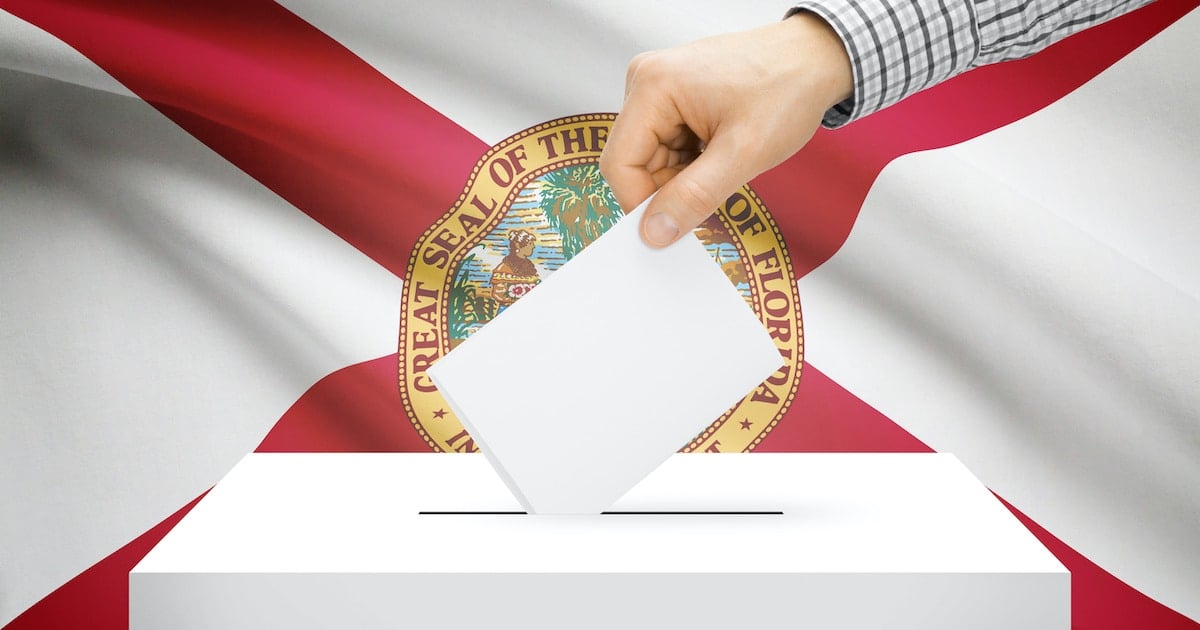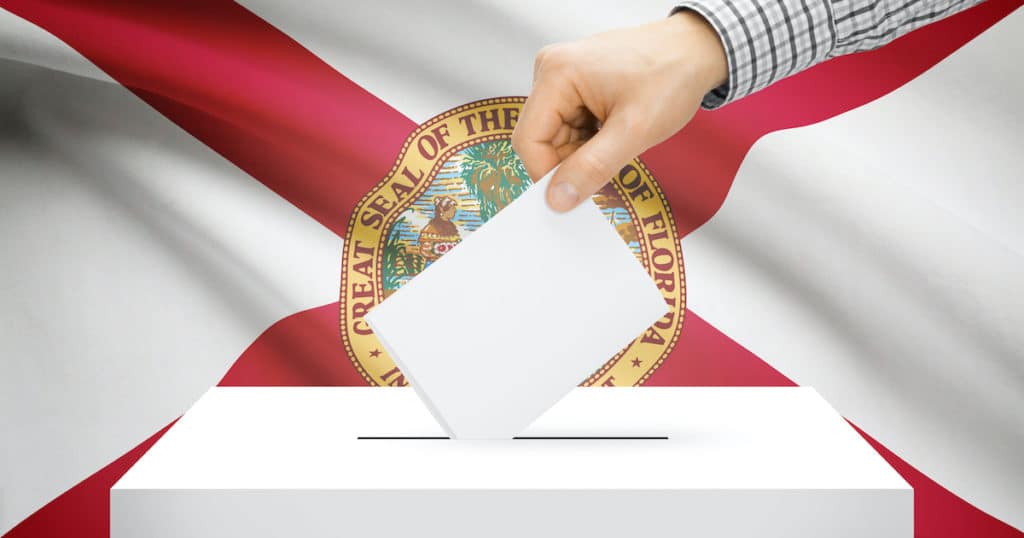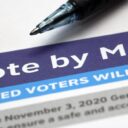
Florida Is Always Close, But Donald Trump Will Be Difficult to Beat

Florida Republicans bucked the national trend in 2018. With a national mood favoring Democrats by 8.4 points, Republican candidates statewide held the governor’s mansion and defeated a three-term incumbent senator.
The PPD Election Projection Model rated Florida Slightly Republican, while big media competitors predicted a Democratic takeover in the gubernatorial election and a hold in the U.S. Senate.
Modeling indicates Donald Trump will be difficult to defeat in November in the Sunshine State. While it’s still early and the state is always close, the data trend indicates the president is favored to carry the state for a second time.
First, let’s take a look at the voter registration trends from 1972 to 2019. Then, we’ll take a look at voter file data, which is updated monthly, and also the machine-learning models.
Current Voter Registration Statistics
The latest month for which voter registration statistics were released by the Florida Department of State was December 2019. Democrats’ share of the overall electorate continued to decline. Republicans and all “Other” voters continued to increase as a share of the overall electorate.
Of the 13,536,830 total active voting population, 4,986,520 Democrats represented 36.8%, while 4,761,405 Republicans represented 35.2% and all “Other” affiliations totaling 3,788,905 represented 28%.
From 2017 to present, “Other” represents the total number of voters who are unaffiliated and affiliated with minor parties. In 2019, unaffiliated voters represented 26.9%, or 3,641,359. Minor parties represented 1.1%, or 1,47,546.
Voter Registration Trend
That updated voter registration statistics represent a continuation of a longterm trend in the state of Florida. At 225,115, Florida Democrats now have the slimmest voter registration advantage over Florida Republicans since tracking statistics in 1972.
Conventional wisdom holds that the narrowing of the gap between Florida Democrats and Florida Republicans is the result of older, white voters switching their voter registration. That explanation is too superficial and outdated.
That’s certainly been a significant factor behind the overall trend, particularly during the era of Barack Obama. But more recent data suggest it isn’t the primary driver in the era of Donald Trump.
In December 2019, a total of 50,733 new voters registered in the state of Florida. Of them, 34% registered as Republicans, while only 29% registered as Democrats.
The largest group, at 37%, registered as either unaffiliated or minor party.
Historical Context
Throughout that same period, no Democratic presidential candidate has ever carried the Sunshine State with an advantage less than 558,272. That was the advantage Democrats held when Barack Obama defeated Mitt Romney in 2012 by just 0.88%, or only 74,309 votes.
In 2016, the Democratic voter registration advantage was 330,428. Donald Trump still defeated Hillary Clinton 49.02% to 47.82%, or 112,911 votes. The PPD Election Projection Model rated the state Leans Trump.
Voter File Analysis
The Voter File Analysis—which again, is sourced by data updated on a monthly basis—is still strikingly similar to the data sourced by the Florida Department of State.
The sample is of 12,443,282 voters to include 5,642,711 total records with landlines, 6,182,122 total records with mobile phones, and 7,421,894 total records with emails.
Voter Registration By Party
| Democrat | 4,616,594 | 37.10% |
| Republican | 4,356,114 | 35.01% |
| None | 3,351,399 | 26.93% |
| Independent | 78,166 | 0.63% |
| Libertarian | 30,438 | 0.24% |
| Green | 6,259 | 0.05% |
| Constitution | 1,723 | 0.01% |
| Reform | 1,344 | 0.01% |
| Other | 1,245 | 0.01% |
| Total | 12,443,282 | 99.99% |
As we can see above, voter registration derived from our Voter File Analysis was spot on juxtaposed to the statistics released by the Florida Department of State.
The total 4,616,594 Democrats represented 37.10%, a near exact match to the 36.7% in the active voter registration statistics. The 4,761,405 Republicans represented 35.01%, also a near exact match (35.2%). The total of nones, minor parties and other was 27.88%, again a near exact match (28%).
Inferred Race/ Ethnicity
| White Caucasian | 7,922,679 | 63.67% |
| Hispanic | 2,186,097 | 17.57% |
| African American | 1,727,310 | 13.88% |
| Asian | 259,600 | 2.09% |
| Unknown | 347,596 | 2.79% |
| Total | 12,443,282 | 100.00% |
In 2016, the exit polls—which we’ve disputed, with good reason—pegged Whites as 62% of the electorate. Blacks were estimated at 14%; Hispanics 18%; Asians 2%; and, 4% unknown or other.
Subsequent analysis suggests Whites were likely 64%, potentially as high as 66%, of the overall electorate in Florida. Nevertheless, the Voter Analysis nearly mirrors reasonable estimates for 2016.
Gender
In 2016, the exit polls found a gender breakdown of 53% female to 47% male. The Voter File Analysis pegged female voters at a total 6,656,142, or 53.49%. Male voters were a total 5,778,496, or 46.44%.
There were 8,644 voters blank for gender, or 0.07%.
Turnout Probability Model Favors Florida Republicans
The Turnout Probability Model uses machine learning technology to accurately predict the likelihood that a voter will vote in a particular election—in this case the U.S. Presidential General Election in Florida.
The model is expressed as a percentage from 1% to 100%, with 100% being the most likely to vote in a particular election. This model is of voters who are more likely to vote than not to vote, meaning the likelihood is greater than 50%.
Worth noting, this is simply a method to determine the composition of the electorate most likely to vote, not the eventual overall electorate. However, it does provide insight into which party has a built-in turnout advantage.
The sample for the Turnout Probability Model is of 7,805,304 voters to include 4,326,453 total records with landlines, 4,221,671 total records with mobile phones, and 4,924,573 total records with emails.
Voter Registration By Party
| Republican | 3,263,606 | 41.81% |
| Democrat | 3,022,699 | 38.73% |
| None | 1,471,530 | 18.85% |
| Independent | 26,604 | 0.34% |
| Libertarian | 15,756 | 0.20% |
| Green | 2,996 | 0.04% |
| Constitution | 939 | 0.01% |
| Reform | 790 | 0.01% |
| Other | 384 | 0.00% |
| Total | 12,443,282 | 99.99% |
This model predicts an advantage of Republican +3.08.
That might sound unrealistic. But consider the electorate was Republican +1 in both 2016 and 2018. Because the national mood was Democrat +8.4 in 2018—a historically unfavorable cycle for first-term incumbent parties—it’s not unreasonable at all to expect a larger turnout advantage in 2020.
The results of the Turnout Probability Model—backed by the results of the previous four election cycles—clearly reveal a slight but significant advantage for Donald Trump and Florida Republicans.
Gender
The Turnout Probability Model also counted a total 4,334,516 female voters, or 55.53%. Male voters totaled 3,468,386, or 44.44%. There were 2,402 voters blank for gender, or 0.03%.
Inferred Race/ Ethnicity
| White Caucasian | 5,413,967 | 69.36% |
| Hispanic | 1,062,259 | 13.61% |
| African American | 1,028,633 | 13.18% |
| Asian | 138,478 | 1.77% |
| Unknown | 161,967 | 2.08% |
| Total | 12,443,282 | 100.00% |
In Florida, statewide elections are won on the margins, particularly presidential elections. Even the more generous Turnout Probability Model using a 40% likelihood still results in Republican +1.55, or 40% to 38.45%.
The Power of Incumbency
The power of incumbency is difficult to overstate. It can resist a negative trend, as it did for Barack Obama in 2012, or it can exacerbate a positive trend, as it did for George Bush in 2004.
In 2020, Donald Trump will benefit from the power of incumbency. But he is also likely to benefit from historically positive voter registration trends and an advantage in partisan turnout.







